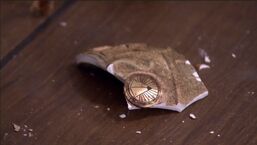Canopic Jar were used by the ancient Egyptians during the mummification process to store and preserve the viscera of their owner for the afterlife. They were commonly either carved from limestone or were made of pottery.[1]
Description[]
These jars were used by the ancient Egyptians from the time of the Old Kingdom until the time of the Late Period or the Ptolemaic Period, by which time the viscera were simply wrapped and placed with the body.[2] The viscera were not kept in a single canopic jar: each jar was reserved for specific organs. The term canopic reflects the mistaken association by early Egyptologists with the Greek legend of Canopus – the boat captain of Menelaus on the voyage to Troy – "who was buried at Canopus in the Delta where he was worshipped in the form of a jar".[3]
The canopic jars were four in number, each for the safekeeping of particular human organs: the stomach, intestines, lungs, and liver, all of which, it was believed, would be needed in the afterlife. There was no jar for the heart: the Egyptians believed it to be the seat of the soul, and so it was left inside the body.
Many Old Kingdom canopic jars were found empty and damaged, even in undisturbed tombs. Therefore it seems that they were never used as containers. Instead, it seems that they were part of burial rituals and were placed after these rituals, empty.[4]

Hieroglyphs for the four sons of Horus used on an Egyptian canopic jar.
The design of canopic jars changed over time. The oldest date from the Eleventh or the Twelfth Dynasty, and are made of stone or wood.[5] The last jars date from the New Kingdom. In the Old Kingdom the jars had plain lids, though by the First Intermediate Period jars with human heads (assumed to represent the dead) began to appear. Sometimes the covers of the jars were modeled after (or painted to resemble) the head of Anubis, the god of death and embalming. By the late Eighteenth Dynasty canopic jars had come to feature the four sons of Horus.[6] Many sets of jars survive from this period, in alabaster, aragonite, calcareous stone, and blue or green glazed porcelain.[7] The sons of Horus were also the gods of the cardinal compass points.[8] Each god was responsible for protecting a particular organ and was himself protected by a companion goddess. They were:
- Hapi, the baboon-headed god representing the North, whose jar contained the lungs and was protected by the goddess Nephthys. Hapi is often used interchangeably with the Nile god Hapi, though they are actually different gods.
- Duamutef, the jackal-headed god representing the East, whose jar contained the stomach and was protected by the goddess Neith.
- Imsety, the human-headed god representing the South, whose jar contained the liver and was protected by the goddess Isis.
- Qebehsenuef, the falcon-headed god representing the West, whose jar contained the intestines and was protected by the goddess Serqet.[9]
Throughout House of Anubis[]
The Sibunas and Sophia found the canopic jar in an excavation in front of the school, thanks to a clipping from the newspaper ("The Cairo Telegraph", March 3, 1890) where some coordinates were seen, then Eric Sweet finds them and snatches the artifact. The canopic jarin the show has the head of Anubis, it is ocher brown in color and has hieroglyphs and relief drawings, but what stands out the most is the symbol of Ra, which appears to be made of shiny metal. In antiquity it keeps the stomach but in the film it is mentioned that it keeps the brain.
Dexter is persuaded by Sophia with the power of the fifth stone, she tells him to bring her the jug but in the meantime he fights with Eddie and the jar is destroyed. Fortunately, Fabian managed to decipher the hieroglyphics inside the jar, part of the story of Ra and his shower of gold is carved there, the Sibunas discover that all the people who touched the stone will be petrified once the sacrifice is made. Inside the jar was an enscription that contains the curse Of The Touchstone and The amulet of Ra. Inside the jar there is also the medal that the sacrifice must carry.
Gallery[]
References[]
- ↑ https://en.wikipedia.org/wiki/Canopic_jar
- ↑ https://en.wikipedia.org/wiki/Canopic_jar#cite_note-2
- ↑ https://en.wikipedia.org/wiki/Canopic_jar#cite_note-3
- ↑ https://www.worldcat.org/search?fq=x0:jrnl&q=n2:1214-3189
- ↑ https://en.wikipedia.org/wiki/Canopic_jar#cite_note-b240-7
- ↑ https://en.wikipedia.org/wiki/Canopic_jar#cite_note-8
- ↑ https://en.wikipedia.org/wiki/Canopic_jar#cite_note-b240-7
- ↑ https://en.wikipedia.org/wiki/Canopic_jar#cite_note-9
- ↑ https://en.wikipedia.org/wiki/Canopic_jar#cite_note-10
[]
| |||||||||||||||||||||||||||||




